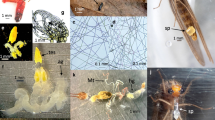Summary
The queens of larger colonies of the primitive ant Amblyopone silvestrii are exclusively dependent on the hemolymph of their own larvae as a nutrient, even when prey feeding is possible. On the other hand, the foundresses suppress larval hemolymph feeding (LHF) when prey is available, allowing them to rear the first workers more swiftly. The nondestructive form of cannibalism can be regarded as a nutritive adaptation related to: (1) the lack of social food transfer in this species, and (2) its specialized predation on large sporadic prey (centipedes). LHF similar to that in Amblyopone was found in Proceratium and another type of LHF, with a larval specialized exudatory organ, in Leptanilla.
Similar content being viewed by others
References
Altmann J (1974) Observational study of behavior: sampling methods. Behaviour 49:227–267
Brian MV (1973) Caste control through worker attack in the ant Myrmica. Insectes Soc 20:87–102
Brian MV (1974) Brood-rearing behaviour in small cultures of the ant Myrmica rubra L. Anim Behav 22:879–889
Brian MV (1980) Social control over sex and caste in bees, wasps and ants. Biol Rev 55:379–415
Brown WL Jr (1957) Predation of arthropod eggs by the ant genera Proceratium and Discothyrea. Psyche 64:115
Brown WL Jr (1958) Contributions toward a reclassification of the Formicidae. II. Tribe Ectatomini (Hymenoptera). Bull Mus Comp Zool Harv Univ 118:175–362
Brown WL Jr (1960) Contributions toward a reclassification of the Formicidae. III. Tribe Amblyoponini (Hymenoptera). Bull Mus Comp Zool Harv Univ 122:145–230
Brown WL Jr (1975) Contributions toward a reclassification of the Formicidae. V. Ponerinae, tribes Platythyreini, Cerapachyini, Cylindromyrmecini, Acanthostichini, and Aenictogitini. Search 5:1–115
Brown WL Jr (1979) A remarkable new species of Proceratium with dietary and other notes on the genus (Hymenoptera: Formicidae). Psyche 86:337–346
Brown WL Jr, Wilson EO (1959) The evolution of the dacetine ants. Q Rev Biol 34:278–294
Gotwald WH Jr, Lévieux J (1972) Taxonomy and biology of a new West African ant belonging to the genus Amblyopone (Hymenoptera: Formicidae). Ann Entomol Soc Am 65:383–396
Haskins CP (1928) Notes on the behavior and habits of Stigmatomma pallipes Haldeman. J NY Entomol Soc 36:179–184
Haskins CP (1970) Researches in the biology and social behavior of primitive ants. In: Aronson LR, Tobach E, Lehrman DS, Rosenblatt JS (eds) Development and evolution of behavior: essays in memory of TC Schneirla. Freeman, San Francisco, pp 355–388
Haskins CP, Haskins EF (1951) Note on the method of colony foundation of the ponerine ant Amblyopone australis Erichson. Am Midl Nat 45:432–445
Hölldobler B (1982) Communication, raiding behavior, and prey storage in Cerapachys (Hymenoptera: Formicidae). Psyche 89:3–23
Kôriba O (1963) Colony founding of a female of Brachyponera chinensis (Emery) in the observation cage (Hymenoptera, Formicidae). Kontyu 31:285–289 (in Japanese with English summary)
Kubota M (1980) Records of ants (2). Ari (Reports of the Myrmecologists' Society, Japan) 9:8 (in Japanese with English synopsis)
Le Masne G (1952) Les echanges alimentaires entre adultes chez la fourmi Ponera eduardi Forel. CR Acad Sci Paris 235:1549–1551
Le Masne G (1953) Observations sur les relations entre le couvain et les adultes chez les fourmis. Ann Sci Nat Zool (Ser 11) 15:1–56
Lévieux J (1972) Comportement d'alimentation et relations entre les individus chez une fourmi primitive, Amblyopone pluto Gotwald et Lévieux. CR Acad Sci Paris 275:483–485
Lévieux J (1982) A comparison of the ground dwelling ant populations between a Guinea savanna and an evergreen rain forest of the Ivory Coast. In: Breed MD, Michener CD, Evans HE (eds) The biology of social insects. Proc 9th Int Congr IUSSI. Westview Press, Boulder, CO, pp 48–53
Lévieux J, Diamonde T (1976) La nutrition des fourmis granivores. II. Cycle d'activité et régime alimentaire de Brachyponera senaarensis (Mayr) (Hymenoptera Formicidae). Insectes Soc 25:187–196
Maschwitz U (1966) Das Speichelsekret der Wespenlarven und seine biologische Bedeutung. Z Vergl Physiol 53:228–252
Masuko K (1984) Studies on the predatory biology of Oriental dacetine ants (Hymenoptera: Formicidae). I. Some Japanese species of Strumigenys, Pentastruma, and Epitritus, and a Malaysian Labidogenys, with special reference to hunting tactics in short-mandibulate forms. Insectes Soc 31:429–451
Onoyama K (1980) An introduction to the ant fauna of Japan, with a check list (Hymenoptera, Formicidae). Kontyu 48:193–212
Traniello JFA (1982) Population structure and social organization in the primitive ant Amblyopone pallipes (Hymenoptera: Formicidae). Psyche 89:65–80
Wheeler WM (1918) A study of some ant larvae, with a consideration of the origin and meaning of the social habit among insects. Proc Am Philos Soc 57:293–343
Wheeler WM (1933) Colony-founding among ants. Harvard University Press, Cambridge, MA
Wheeler WM (1936) Ecological relations of ponerine and other ants to termites. Proc Am Acad Arts Sci 71:159–243
Wilson EQ, (1971) The insect societies. Harvard University Press, Cambridge, MA
Author information
Authors and Affiliations
Rights and permissions
About this article
Cite this article
Masuko, K. Larval hemolymph feeding: a nondestructive parental cannibalism in the primitive ant Amblyopone silvestrii Wheeler (Hymenoptera: Formicidae). Behav Ecol Sociobiol 19, 249–255 (1986). https://doi.org/10.1007/BF00300639
Received:
Accepted:
Issue Date:
DOI: https://doi.org/10.1007/BF00300639




